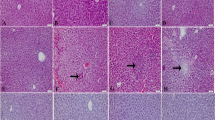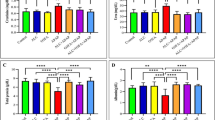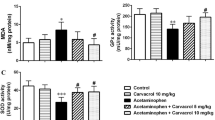Abstract
Hepatic injury by acetaminophen (APAP) has been extensively studied, although the alterations of renal functions and arterial blood pressure (ABP) after APAP exposure are still uncertain, and the impact of Nigella sativa oil (NSO) in this case is poorly defined. Sixty adult male albino rats were involved in two sets of experiments. The first was exposed to a single high dose of APAP (2.5 g/kg) orally preceded by 4 ml NSO/kg orally, while the second received 750 mg APAP/kg/day orally for seven consecutive days and was pretreated with 2 ml NSO/kg/day. Proximal tubular injury was assessed by laboratory and histological studies, and arterial blood pressure was recorded in all animals. In both experiments, urinary α-glutathione S-transferase and neutral endopeptidase, and microproteinuria were dramatically increased early indicating glomerulus and proximal tubule dysfunction that was mediated by raising 8-isoprostanes. Concomitantly, urinary albumin, total protein, creatinine, urea, glomerular filtration rate, Na and K levels, plasma creatinine, and urea were all changed significantly after APAP administration. Currently, ABP increased significantly after APAP which was mostly mediated by renal impairment and increased both renin activity and aldosterone secretion. Pretreatment with NSO produced significant normalization of physiological parameters as well as suppression of structural changes. In conclusion, measurement of urinary biomarkers can be considered a powerful tool for early screening of renal injury and alteration of ABP after APAP treatment. Concomitant administration of NSO can counterbalance these detrimental effects.






Similar content being viewed by others
References
Abdel-Zaher AO, Abdel-Rahman MS, El wasei FM (2008) Blockage of nitric oxide overproduction and oxidative stress by Nigella sativa oil attenuates morphine-induced tolerance and dependence in mice. Neurochem Res 35:1557–1565
Abdel-Zaher AO, Randa HA, Madeha MM, Magda MY (2008) The potential protective role of alpha-lipoic acid against acetaminophen-induced hepatic and renal damage. Toxicol 243:261–270
Abou Basha LI, Rashed MS, Aboul-Enein HY (1965) TLC assay of thymoquinone in black seed oil (Nigella sativa) and identification of dithymoquinone and thymol. J Liq Chroatogr 18(1):105–115
Ahmad ST, Arjumand W, Nafees S, Seth A, Ali N, Rashid S, Sultana S (2012) Hesperidin alleviates acetaminophen induced toxicity in Wistar rats by abrogation of oxidative stress, apoptosis and inflammation. Toxicol Lett 208(2):149–161
Anderson JV, Donckier J, Payne N et al (1987) Atrial natriuretic peptide: evidence of action as a natriuretic hormone at physiological plasma concentrations in man. Clin Sci 72:305–312
Anurag P, Manu C, Brij MS, Ankush G, Rajesh S (2010) Acute toxicity studies of paracetamol infusion in albino Wistar rats. Intern J Pharmaceutical Sci Drug Res 2(2):142–145
Badary OA, Taha RA, AM Gamal el-Din, Abdel-Wahab MH (2003) Thymoquinone is a potent superoxide anion scavenger. Drug Chem Toxicol 26:87–98
Bayrak O, Bavbek N, Karatas OF, Bayrak R, Catal F, Cimentepe E, Akbas A, Yildirim E, Unal D, Akcay A (2008) Nigella sativa protects against ischaemia/reperfusion injury in rat kidneys. Nephrol Dial Transplant 23(7):2206–2212
Bertolini A, Ferrari A, Ottani A, Guerzoni S, Tacchi R, Leone S (2006) Paracetamol: new vistas of an old drug. CNS Drug Rev 12:250–275
Blantz RC (1996) Acetaminophen: acute and chronic effects on renal function. Am J Kidney Dis 28(1 Suppl 1):S3–S6
Burits M, Bucar F (2000) Antioxidant activity of Nigella sativa essential oil. Phytother Res 14:323–328
Catherine L, Frédéric DD, Volker MA, Agnieszka P, Eric GD, David HP, Monique MD, Jean-Louis V, Joe LN (2005) Early proximal tubule injury in experimental aristolochic acid nephropathy: functional and histological studies. Nephrol Dial Transplant 20:2321–2332
Chandrasekharan NV, Dai H, Roos KL, Evanson NK, Tomsik J, Elton TS, Simmons DL (2002) COX-3, a cyclooxygenase-1 variant inhibited by acetaminophen and other analgesic/antipyretic drugs: cloning, structure, and expression. Proc Natl Acad Sci USA 99:13926–13931
Cohen SD, Khairallah EA (1997) Selective protein arylation and acetaminophen induced hepatotoxicity. Drug Metab Rev 29:59–77
da Silva Melo DA, Saciura VC, Poloni JA, Oliveira CS, Filho JC, Padilha RZ, Reichel CL, Neto EJ, Oliveira RM, D'avila LC, Kessler A, de Oliveira JR (2006) Evaluation of renal enzymuria and cellular excretion as an marker of acute nephrotoxicity due to an overdose of paracetamol in Wistar rats. Clin Chim Acta 373:88–91
Daba B (1998) and Abdel Rhman M. Hepatoprotective activity of thymoquinone in isolated rat hepatocytes Toxicol Lett 95:23–29
Forman JP, Rimm EB, Curhan GC (2007) Frequency of analgesic use and risk of hypertension among men. Arch Intern Med 167:394–399
Graham GG, Scott KF (2005) Mechanism of action of paracetamol. Am J Ther 12:46–55
Gujral JS, Knight TR, Farhood A, Bajt ML, Jaeschke H (2002) Mode of cell death after acetaminophen overdose in mice: apoptosis or oncotic necrosis? Toxicol Sci 67:322–328
Hanly LN, Chen N, Aleksa K, Cutler M, Bajcetic M et al (2012) N-Acetylcysteine as a novel prophylactic treatment for ifosfamide-induced nephrotoxicity in children: translational pharmacokinetics. J Clin Pharmacol 52(1):55–64
Hinz B, Cheremina O, Brune K (2008) Acetaminophen (paracetamol) is a selective cyclooxygenase-2 inhibitor in man. FASEB J 22:383–390
Houghton PJ, Zarka R, de la Heras B, Hoult JRS (1995) Fixed oil of Nigella sativa and derived thymoquinone inhibit eicosanoid generation in leukocytes and membrane lipid peroxidation. Planta Med 61:33–36
Ichimura T, Hung CC, Yang SA, Bonventre JV (2004) Kidney injury molecule-1: a tissue and urinary biomarker for nephrotoxicant-induced renal injury. Am J Physiol Renal Physiol 286:F552–F563
Isabella S, Andreas JF, Daniel P, Frank E, Matthias H, Mathias W, Astrid H, Priska K, David H, Michel N, Steffen G, Johannes H, Juerg N, Pavani M, Landmesser UF, Sarah RH, Roberto C, Paul MV, Thomas FL, Georg N (2010) Acetaminophen increases blood pressure in patients with coronary artery disease. Circulation 122:1789–1796
Ismail M, Al-naqeep G, Chan KW (2009) Nigella sativa thymoquinone-rich fraction greatly improves plasma antioxidant capacity and expression of antioxidant genes in hypercholesterolemic rats. Free Radic Biol Med 48:664–672
Jaeschke H, Knight TR, Bajt ML (2003) The role of oxidant stress and reactive nitrogen species in acetaminophen hepatotoxicity. Toxicol Lett 144:279–288
Jean-Charles G, Bjö Rn R, Jakob W, Petra K, Lou M, ValéRie G, Norman B, Thierry G, David H, Daniela E, Kerstin S, Ernie H, And Syril P (2010) Evaluation of novel biomarkers of nephrotoxicity in two strains of rat treated with cisplatin. Toxicol Pathol 38:943–956
Kon JS, Kim H, Jaeschke H, Lemasters JJ (2004) Mitochondrial permeability transition in acetaminophen-induced necrotic and apoptotic cell death to cultured mouse hepatocytes. Hepatology 40:1170–1179
Mahmoud NN, Hussain AA, Mohamed MSA, Abdullah MAB (2010) Thymoquinone supplementation reverses acetaminophen-induced oxidative stress, nitric oxide production and energy decline in mice liver. Food and Chemical Toxicology 48:2361–2365
Mazer M, Perrone J (2008) Acetaminophen-induced nephrotoxicity: pathophysiology, clinical manifestation, and management. J Med Toxicol 4(1):2–6
Montgomery B (2008) Does paracetamol cause hypertension? BMJ 336:1190–1191
Moore K, Roberts LJ (1998) Measurement of lipid peroxidation. Free Radic Res 28:659–671
Mour G, Feinfeld DA, Cacaccio T, Mc Guigan M (2005) Acute renal dysfunction in acetaminophen poisoning. Renal Fail 27:381–383
Nanji AA, Khwaja S, Tahan SR, Sadrzadeh SM (2011) Plasma levels of a novel noncyclooxygenase-derived prostanoid (8-isoprostane) correlate with severity of liver injury in experimental alcoholic liver disease. J of pharmacology 339:45–49
O'Grady JG (1997) Paracetamol-induced liver failure: prevention and management. J Hepatol 26:41–46
Panos MZ, Anderson JV, Forbes A, Payne N, Slater JDH, Rees L, Roger W (1991) Human atrial natriuretic factor and reninaldosterone in paracetamol induced fulminant hepatic failure. Gut 32:85–89
Paolo M, Sergei AK, Giovanni C, Massimo C, van Liesbeth R, Duncan MG, Margaret EH, Peter JB (2000) Exhaled 8-isoprostane as a new non-invasive biomarker of oxidative stress in cystic fibrosis. Thorax 55:205–209
Qiu LZ, Benet AL, Burlingame Y (2001) Identification of hepatic protein targets of the reactive metabolites of the non-hepatotoxic regioisomer of acetaminophen, 30-hydroxyacetanilide, in the mouse in vivo using two dimensional gel electrophoresis and mass spectrometry. Adv Exp Med Biol 500:663–673
Radack KL, Deck CC, Bloomfield SS (1987) Ibuprofen interferes with the efficacy of antihypertensive drugs: a randomized, double-blind, placebo controlled trial of ibuprofen compared with acetaminophen. Ann Intern Med 107:628–635
Roomi MW, Kalinovsky T, Ivanov V, Rath M, Niedzwiecki A (2008) A nutrient mixture prevents acetaminophen hepatic and renal toxicity in ICR mice. Hum Exp Toxicol 27(3):223–230
Russo LM, Sandoval RM, McKee M, Osicka TM, Collins AB, Brown D, Molitoris BA, Comper WD (2007) The normal kidney filters nephrotic levels of albumin retrieved by proximal tubule cells: retrieval is disrupted in nephrotic states. Kidney Int 71:504–513
Schwab JM, Schluesener HJ, Laufer S (2003) COX-3: just another COX or the solitary elusive target of paracetamol? Lancet 361:981–982
Stevens LA, Coresh J, Greene T, Levey AS (2006) Assessing kidney function—measured and estimated glomerular filtration rate. N Engl J Med 354(23):2473–2483
Tonomura Y, Tsuchiya N, Torii M, Uehara T (2010) Evaluation of the usefulness of urinary biomarkers for nephrotoxicity in rats. Toxicology 273:53–59
Vaidya VS, Ferguson MA, Bonventre JV (2008) Biomarkers of acute kidney injury. Annu Rev Pharmacol Toxicol 48:463–493
Worthen DR, Ghosheh OA, Crooks PA (1998) The in vitro anti-tumor activity of some crude and purified components of blackseed, Nigella sativa L. Anticancer Res 18:1527–1532
Acknowledgments
This work was supported by the research grant office of the Assiut University Faculty of Medicine. The authors wish to thank Professor Zedan Z. Ibraheim, Pharmacognosy Department, Faculty of Pharmacy, Assiut University, for his scientific assistance in the analyzing and identifying of NSO, and Dr. Amal Ratab and Dr. Amal Marzouq, associate professors of anatomy and histology, Anatomy and Histology Departments, Faculty of Medicine, Assiut University, Assiut/Egypt, for their kind help in histological assessments.
Author information
Authors and Affiliations
Corresponding author
Rights and permissions
About this article
Cite this article
Ahmed, O.G., El-Mottaleb, N.A.A. Renal function and arterial blood pressure alterations after exposure to acetaminophen with a potential role of Nigella sativa oil in adult male rats. J Physiol Biochem 69, 1–13 (2013). https://doi.org/10.1007/s13105-012-0182-y
Received:
Accepted:
Published:
Issue Date:
DOI: https://doi.org/10.1007/s13105-012-0182-y




